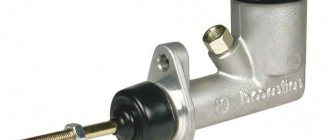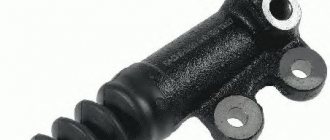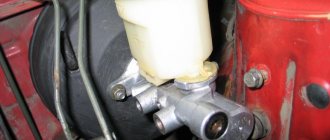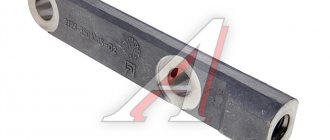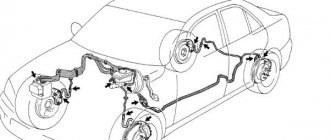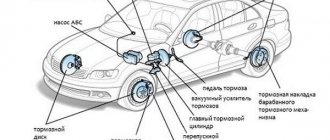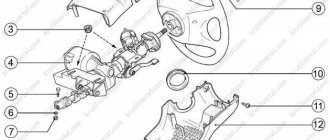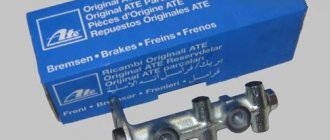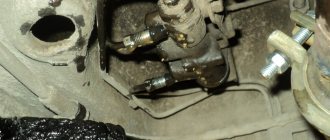If we simplify the formulation of the actions performed by the clutch drive, it will sound like this - the transmission of torque from the motor to the corresponding gearbox shaft with the ability to disable and then softly engage after switching to the desired gear. Nowadays, designers have not yet come up with anything more effective for achieving this goal than a hydraulic clutch drive.
The diagram and principle of operation of the described device is simple: a depressed pedal acts on the clutch cylinder rod, which, accordingly, using hydraulic fluid located in the tank through tubes, activates, through the working cylinder, the fork and the release bearing.
Failure of the clutch drive occurs for several reasons, one of which may be a faulty clutch master cylinder; in order to repair it, it is advisable to understand its structure, signs indicating the inoperability of the mechanism, methods of repair, and if repair is not possible, then how to make it replacement.
Possible malfunctions and their diagnosis
Signs indicating malfunctions in the clutch drive can be diagnosed based on the following:
- The level in the clutch reservoir has dropped significantly, this indicates that brake fluid is leaking somewhere in the system; if the connecting pipes are intact, this may be due to worn cuffs or a faulty piston in the master cylinder.
- A visual inspection showed the presence of places where fluid was leaking: tubes, cuffs, etc.
- When pressed, periodic failures of the pedal occur, this indicates that there is air in the clutch drive, this happens when hoses are cracked or when the level in the reservoir drops below “nowhere”.
- When shifting gears, a characteristic sound is heard in the gearbox, reminiscent of a “crunch”; the cause may be a malfunction of the piston or spring of the master cylinder.
If the symptoms described above are present, you should not tighten and more carefully check all the parts responsible for the operation of the clutch drive. Otherwise, it may happen that postponing repair of the clutch master cylinder will lead to unpleasant consequences, the least of which could be repair of the gearbox.
Design of the mechanism for connecting the internal combustion engine and transmission of a car
In order to carry out work with such an important unit for the machine, you need to know its structure and how it interacts with other transmission elements.
There are several types of automobile clutch, which differ in different ways:
- according to the nature of friction, it can be dry, that is, the clutch basket and friction disc work in an air environment, and wet - when the clutch elements are immersed in an oil bath;
- By the number of driven or friction disks, single-, double- or multi-disk devices are distinguished;
- These units are distinguished by the drive with which they are controlled - this is a mechanical, hydraulic, pneumatic or combined method of controlling the mechanism.
The most common is a dry friction single-disc mechanism connecting the gearbox to the engine, which is installed on passenger cars with a manual transmission.
More than one driven disk is used when the clutch basket is installed on trucks and tractors. An oil bath is done on motorcycle equipment.
In a similar passenger car transmission mechanism, a friction disk mounted on the splines of the drive shaft is pressed against the flywheel. The clutch basket, which includes a drive or pressure plate, springs and a casing, is located on the same shaft as the driven disk. Behind it are the release bearing, clutch, as well as springs, rods and drive pedal.
Repair work
If the pedal fails, in order to avoid unreasonable disassembly of the cylinder, it is worth initially pumping the system and expelling air from there that could get in when the liquid in the tank drops below the minimum permissible level. If this does not help in principle, it is worth starting repairs. For this case, there is a repair kit for the clutch master cylinder on sale, which, depending on the make of the car, contains the main wearing parts: cuffs, return spring, rod, retaining ring, etc.
Clutch master cylinder design
The principle of the clutch master cylinder is not particularly complicated. The clutch master cylinder consists of the following main parts:
- a tank located on the body, in some cases next to it;
- bypass fitting;
- protective case;
- pusher rod;
- outer cuff;
- rod (piston);
- internal sealing collar;
- cylinder body;
- return spring.
Work performed during replacement
The procedure required when replacing the clutch master cylinder is simple:
- Having unscrewed the tank, use a syringe to pump out the hydraulic fluid;
- disconnect the master cylinder from the clutch pedal, which is sometimes difficult;
- disconnect all hoses and plug those from which liquid is flowing;
- unscrew the nuts securing the cylinder to the car body;
- replace with a new clutch master cylinder and install in the reverse order;
- bleed the clutch system.
For the clutch bleeding procedure you will need:
- a suitable bleeding hose that fits tightly onto the air valve located on the working cylinder;
- container for draining hydraulic fluid;
- corresponding key for the valve;
- the liquid itself.
To pump, you should: remove the protective cap from the valve, put a hose in its place, the second end of which should be lowered into the liquid in the container.
Have an assistant press the clutch pedal several times and then hold it down. After turning the valve 4-5 turns, let the liquid with air bubbles drain out and screw the valve back. After performing the same actions several times, you should pump the system until all air is removed from it.
We also recommend watching videos on the topic:
The main purpose of the clutch master cylinder is that it transmits force to the slave cylinder from the clutch pedal using working fluid.
If the master cylinder is faulty, vehicle control will be impaired and it will be impossible to disconnect the transmission from the engine.
How to determine if the clutch master cylinder is faulty:
- Periodically check the level of working fluid in the tank. A sharp decrease in it will indicate a system malfunction;
- check for leaks in the main and working cylinder housings;
- failure of the clutch pedal, which occurs due to the entry and accumulation of air in the clutch system;
- underpressure of the pedal and vibration of the gear shift lever.
Which one is better to put
On the VAZ 2101 it is necessary to install a hydraulic clutch designed for the VAZ 2101–07. Cylinders designed to work in UAZ, GAZ and AZLK vehicles are not suitable for installation on a “penny” car. The situation is similar with imported analogues. It will be quite problematic to introduce a GVC from any foreign car, which is due to different mounting of the unit, different threads and tube configuration. However, a hydraulic drive from a VAZ 2121 or from a Niva-Chevrolet is suitable for the “classic”.
Manufacturer's choice
Today there are many companies that manufacture clutch master cylinders. However, when choosing and purchasing the unit in question, preference should be given to the following manufacturers:
- JSC AvtoVAZ;
- Brick LLC;
- Kedr LLC;
- Fenox;
- ATE;
- TRIALLI.
When choosing GVCs, it is better to give preference to well-known manufacturers
The average cost of a hydraulic clutch is 500–800 rubles. However, there are products that cost about 1,700 rubles, for example, cylinders from ATE.
Table: comparison of hydraulic clutch actuators from different manufacturers by price and reviews
| Manufacturer, country | Trademark | Cost, rub. | Reviews |
| Russia, Tolyatti | AvtoVAZ | 625 | Original GVCs are made with high quality and are more expensive than analogues |
| Belarus | Fenox | 510 | Original GVCs are inexpensive, made with high quality, and are popular among drivers |
| Russia, Miass | Brick Basalt | 490 | Improved design: the absence of a technological plug at the end of the cylinder and the presence of an anti-vacuum cuff increases the reliability of the product |
| Germany | AND THOSE | 1740 | The originals are of the highest quality. The price is tied to the EURO exchange rate |
| Germany | HORT | 1680 | Original GCS are reliable and durable in operation. The price is tied to the EURO exchange rate |
| Russia, Miass | Cedar | 540 | The original GVCs do not cause any particular complaints |
Replacement
The cost of this type of work in a car service starts from 550 rubles. But for most car enthusiasts, this operation is not so difficult to perform on their own.
- new GVC;
- brake fluid;
- set of wrenches with extension;
- syringe or rubber bulb.
- Pump out the fluid from the hydraulic drive reservoir using a syringe or rubber bulb.
- Remove the expansion tank and move it to the side so that it does not interfere with work.
- Unscrew the tube with a 13mm wrench. Move it a little.
- Loosen the clamp and disconnect the rubber hose that goes from the tank to the cylinder.
- Unscrew the two nuts with a 13mm socket wrench and an extension.
- Remove the master cylinder from the studs.
- Replace the GCS with a new one.
- Reassemble everything in reverse order.
Bleeding the clutch
The replacement has been made, but you should not hit the road without bleeding the clutch system. The process is similar to bleeding the brakes and is carried out in the following sequence:
- Brake fluid is poured into the reservoir.
- A hose is put on the master cylinder fitting, the other end is lowered into a bottle filled with liquid. This will show how air leaves the system during the pumping process.
- The operation requires an assistant. One sits in the car and presses the clutch pedal 5-6 times on command, after which he leaves it pressed. The second one opens the fitting until the release of air stops. This is done several times until all air is removed from the clutch system.
- Tighten the fitting and add fluid to the reservoir.
Repair of driven disks
The driven disk may have defects:
- friction lining wear
- loosening the hub rivets
- disk warping
- hub spline wear
The disc is rejected when there are cracks and fractures, the holes are worn to the limit, and the hub is rejected when the splines are worn to the limit.
Loose rivets are removed. Holes are drilled simultaneously in the hub, disk and oil deflector washer and riveted with hot rivets. Loose rivets must not be tightened.
Friction linings that are worn out in thickness are replaced with new ones. New linings are riveted with hollow rivets made of non-ferrous metals or glued with VS-YUT or BF-52T glue. To make rivets, copper or brass tubes of the appropriate diameter are used. The heads of the rivets in the new linings should be recessed by 1.0-1.5 mm. The leakage of the surface of the lining should not exceed 0.3 mm. When using overlays in the form of separate sectors, their difference in thickness in one set should not exceed 0.1 mm. A pneumatic press is used to rivet the linings to the driven disks.
Gluing the linings compared to riveting increases productivity by almost 3 times, saves non-ferrous metal, increases the friction surface of the linings and their service life, and reduces scuffing of the working surfaces of pressure and intermediate disks. The technology for gluing overlays is discussed above.
The warpage of the driven disks is determined by the end runout on the device. Correct warping by straightening the slab before riveting (gluing) the overlays.
Pro Tips
The clutch master cylinder is one of the most important elements of any modern car. It is recommended to closely monitor this part of the car, as well as the work of other important organs of the car. A normally functioning cylinder will save the vehicle owner from unpleasant situations on the road, such as a failed clutch pedal, a poorly shifting gear, or a complete failure of the entire system.
The main advice is not to leave any problem that arises unattended and use only proven spare parts from well-known global manufacturers.
Popular manufacturers
All major car manufacturers equip them with clutch master cylinders of their own production, which are fully compatible with a particular car model and of excellent quality. But the market offers products from third-party manufacturers that are not original spare parts. Among such companies that produce clutch master cylinders for various car models from various manufacturers, the most popular are the following:
- Sachs. A German company that produces products that fully comply with the quality certificates of the following manufacturers: VW, Audi, Volvo, BMW, most domestic cars, and supplies them to Formula 1 cars.
- TRW. World leader in the production of quality clutch cylinders for dozens of different automakers. All products have quality certificates ISO 9002, MIRA, RBA, TUV.
- Metelli. An Italian company that produces products using an automated computer control system and ensures that all parameters of the products comply with the ISO 9002 quality system.
- Febi. Manufacturer of quality products certified ISO 9002.
- Herzog. A German manufacturer that produces clutch cylinders for both passenger cars and trucks, including domestic models.
- Valeo. A French company specializing in the production of high-quality components, including clutch cylinders for BMW, Ford, General Motors, as well as other manufacturers, including domestic ones.
Lada 2105 engine crackles and does not start
adjust the terminal on the battery... both terminals... clean and tighten... check the ground on the body and on the engine...
The solenoid relay on the starter does not work. Here either the contacts in the ignition switch are worn out and there is a large voltage drop on them (the solenoid relay does not have enough voltage to operate normally), or the relay itself is not working properly. In the first case, you can directly apply +12 from the battery to the retractor with the ignition switch on.
As a last resort, you can start with a tow, but this is not recommended... You need to install an additional relay to relieve the contacts in the ignition switch
The designers incorporated several innovative technical solutions into the VAZ 2105 engine. Firstly, the valve does not bend when the transmission breaks, and secondly, rotation is transmitted to the timing camshaft by a toothed belt.
How does a chainsaw engine work?
The devices released in the near future have a single-cylinder, two-stroke, carburetor-type engine. Or rather, how to unscrew the clutch cup on a stihl. How to remove the shaft on a trimmer. It contains several devices that work harmoniously. Replacing the clutch on a lawn mower. hd. #clutches, #how to remove the clutch. Main components of the motor:
- Flywheel;
- coupling;
- Incendiary module;
- Muffler;
- Mounting sleeve.
The engine installed in the saw operates at a frequency of 13.5 thousand revolutions/minute, and therefore requires treatment with high-quality oil. A high level of system cooling is required during operation. The engine of the unit is equipped with a cooling system that supplies air to cool the systems.
Brushcutter repair and review.
Symptoms of problems
The general technical condition of the car (including the brake system) can be checked using a personal diagnostic adapter - a car scanner. These types of devices are widespread and have a wide price range.
We would like to draw your attention to the budget model of Korean production Scan Tool Pro Black Edition
At a cost of about 2 thousand rubles. This scanner is capable of fully diagnosing your car (engine, gearbox, transmission, abs, srs and much more), which will pay for itself in 1-2 trips to the service station. The adapter is quite easy to use, has Russian-language software and is compatible with most cars produced in 1993. The device will also be useful when buying a used car, as it can show its real mileage and VIN.
The fluid brake system consists of many parts that can become unusable: pipes, wheel cylinders, calipers, drums and pads. Typical signs of a faulty master cylinder:
- After pressing the pedal, the car stops slowly. The reason is that the cuffs of one or two pistons have lost their tightness - they have cracked or “floated”.
- To slow down, you need to press the brake pedal hard. The phenomenon occurs due to swelling of the rubber of the piston seals.
- The brake pedal travel is too short. The fluid inside the cylinder has nowhere to go because the compensation hole is clogged. Another option is that the passage is blocked by a swollen rubber seal.
- A common symptom is pedal failure, the brakes coming on at the end of the stroke. This indicates complete wear of the cuffs; as a result, liquid penetrates behind the piston and rushes into the expansion tank - the cylinder “bypasses.”
- The pads do not release the brake discs and drums and get very hot when driving. Options: one of the pistons is jammed or the bypass hole is clogged.
The listed symptoms of a GTZ malfunction are similar to malfunctions of other elements. Pedal failure also occurs when a large amount of air enters the tubes or loss of fluid in one of the working cylinders. Sluggish deceleration and increased force on the pedal are often caused by a breakdown of the vacuum booster - a cracked membrane or a lack of tightness at the joints of the hose that takes off engine vacuum.
There are signs that clearly indicate the performance of the main hydraulic cylinder and the malfunction of other elements:
- during braking, the car pulls to the side - the problem lies in a certain circuit or wheel;
- jamming of the brake mechanisms of one wheel;
- creaking and squeaking when braking;
- heating the discs and pads on one wheel.
If you eliminate these symptoms, it will become easier to check the brake master cylinder in a garage. This also includes obvious brake fluid leaks and the knocking sound of worn calipers.
